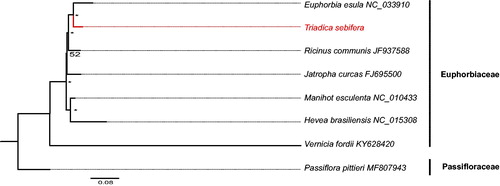Abstract
Triadica sebifera, commonly known as Chinese tallow, is an important medicinal and biofuel plant native to eastern Asia. In the study, we assembled the complete chloroplast genome of T. sebifera based on Illumina pair-end sequencing data. The complete genome sequence length is 159,342 bp. Finally, 122 genes were identified, including 82 protein-coding genes, 8 rRNA genes, and 36 tRNA genes. Further phylogenomic analysis showed that T. sebifera is clustered with Euphorbia esula.
As an important economic species in East Asia, Triadica sebifera has been an aggressive invasive species in the United States since the mid-1900s (Bower et al. Citation2009). Triadica sebifera is a valuable oilseed-producing tree of which roots are used as a medicine to detoxify snakebites and is a promising biofuel feedstock candidate (Divi et al. Citation2016). Triadica comprising three species is a genus of subfamily Euphorbioideae (Tokuoka Citation2007). It was reported that T. sebifera diverged first within this genus, and T. cochinchinensis and T. rotundifolia were sister species (Wang et al. Citation2016). However, the phylogenetic relationships of Euphorbiaceae (the largest family of Malpighiales) were mostly poorly resolved in the previous studies (Tokuoka Citation2007; Wurdack and Davis Citation2009). In the study, the first complete chloroplast genome of Triadica was reported. It will provide potential genetic resources for further population genetic study of T. sebifera and phylogenomic study of Euphorbiaceae.
The T. sebifera individual was collected from Chun’an, Zhejiang, China (Voucher No. ZSTU00904, deposited at Zhejiang Sci-Tech University). DNA was extracted from its silica dried leaves using DNA Plantzol Reagent (Invitrogen, Carlsbad, CA, USA) in accordance with the manufacturer’s instructions. The plastome sequences were generated using the Illumina HiSeq 2500 platform (Illumina Inc., San Diego, CA, USA). In total, about 20.9 million high-quality clean reads (150 bp PE read length) were generated with adaptors trimmed. Aligning, assembly, and annotation were conducted by CLC de novo assembler (CLC Bio, Aarhus, Denmark), BLAST, GeSeq (Tillich et al. Citation2017), and GENEIOUS v 11.0.5 (Biomatters Ltd, Auckland, New Zealand).
The length of the complete chloroplast sequence (GenBank Accession No. MK125518) is 159,342 bp, consisting of a large single copy region (LSC with 87,223 bp), a small single copy region (SSC with 181,65 bp), and two inverted repeat regions (IR with 26,977 bp). The GC content of T. sebifera chloroplast genome was 35.6%. A total of 122 genes were included in the genome (82 protein-coding genes, 8 rRNA genes, and 36 tRNA genes). Sixteen genes had two copies, which were comprised of 6 PCG genes (ndhb, rps7, rps19, ycf1, rpl2, rpl23), 6 tRNA genes (trnl-CAU, trnv-GAC, trnl-GAU, trna-UGC, trnR-ACG, trnN-GUU), and all 4 rRNA species (rrn16, rrn23, rrn4.5, rrn5). In the genome, 6 protein-coding genes (atpF, rpl2, ndhb, ndha, rpl2) had one intron, and clpP gene contained two introns.
We obtained all seven published chloroplast genomes of Euphorbiaceae and one accession of Passifloraceae from NCBI. Alignment of plastomes was generated by MAFFT v7.3 (Katoh and Standley Citation2013). A phylogenetic tree was constructed by IQTREE v1.6.7 (Nguyen et al. Citation2015), with the best selected TVM + F+R3 model and 5000 bootstrap replicates. The result showed that T. sebifera is clustered with Euphorbia esula ().
Disclosure statement
The authors report no conflicts of interest. The authors alone are responsible for the content and writing of the paper.
Additional information
Funding
References
- Bower MJ, Aslan CE, Marcel R. 2009. Invasion potential of Chinese tallowtree (Triadica sebifera) in California's Central Valley. Invasive Plant Sci Manag. 2:386–395.
- Divi UK, Zhou X-R, Wang P, Butlin J, Zhang D-M, Liu Q, Vanhercke T, Petrie JR, Talbot M, White RG, et al. 2016. Deep sequencing of the fruit transcriptome and lipid accumulation in a non-seed tissue of Chinese tallow, a potential biofuel crop. Plant Cell Physiol. 57:125.
- Katoh K, Standley DM. 2013. MAFFT multiple sequence alignment software version 7: improvements in performance and usability. Mol Biol Evol. 30:772–780.
- Nguyen L-T, Schmidt HA, von Haeseler A, Minh BQ. 2015. IQ-TREE: a fast and effective stochastic algorithm for estimating maximum-likelihood phylogenies. Mol Biol Evol. 32:268–274.
- Tillich M, Lehwark P, Pellizzer T, Ulbricht-Jones ES, Fischer A, Bock R, Greiner S. 2017. GeSeq-versatile and accurate annotation of organelle genomes. Nucleic Acids Res. 45:W6–W11.
- Tokuoka T. 2007. Molecular phylogenetic analysis of Euphorbiaceae sensu stricto based on plastid and nuclear DNA sequences and ovule and seed character evolution. J Plant Res. 120:511–522.
- Wang S, Chen Y, Yang Y, Wu W, Liu Y, Fan Q, Zhou R. 2016. Phylogenetic relationships and natural hybridization in Triadica inferred from nuclear and chloroplast DNA analyses. Biochem Syst Ecol. 64:142–148.
- Wurdack KJ, Davis CC. 2009. Malpighiales phylogenetics: gaining ground on one of the most recalcitrant clades in the angiosperm tree of life. Am J Bot. 96:1551–1570.

